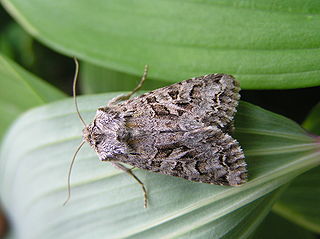
Mohave or Mojave (Mojave: 'Aha Makhav) are a Native American people indigenous to the Colorado River in the Mojave Desert. The Fort Mojave Indian Reservation includes territory within the borders of California, Arizona, and Nevada. The Colorado River Indian Reservation includes parts of California and Arizona and is shared by members of the Chemehuevi, Hopi, and Navajo peoples.

The Mojave River is an intermittent river in the eastern San Bernardino Mountains and the Mojave Desert in San Bernardino County, California, United States. Most of its flow is underground, while its surface channels remain dry most of the time, with the exception of the headwaters and several bedrock gorges in the lower reaches.

Daggett is an unincorporated community located in San Bernardino County, California in the United States. The town is located on Interstate 40 ten miles (16 km) east of Barstow. The town has a population of about 200. The ZIP code is 92327 and the community is inside area code 760.

Aphonopelma is a genus of tarantulas, members of which are native to the Americas. It includes nearly all of the North American tarantulas north of Mexico and a considerable part of the tarantulas which range into Central America. About 90 species have been described, but many, if not most, of these are inadequately studied and very little is known about them. Most are large, and like other New World tarantulas, they have urticating hairs. Most are docile in captivity. Their taxonomy is poorly understood and species are difficult to tell apart, especially those that are brown or black without other pattern. In captivity, they are usually fed crickets; in the wild, they eat most insects, including crickets, grasshoppers, cockroaches, mantises, and beetles. Most species found in the Southwestern United States have an adult legspan of 4.5 in (11.5 cm), though some Arizona species have been known, on occasion, to exceed 6 in (16 cm).

Tetracoccus is a plant genus under the family Picrodendraceae. Shrubby-spurge is a common name for plants in this genus.

The Serrano are an indigenous people of California. They use the autonyms of Taaqtam, meaning "people"; Maarenga'yam, "people from Morongo"; and Yuhaviatam, "people of the pines." Today the Maarenga'yam are enrolled in the Morongo Band of Mission Indians, and the Yuhaviatam are enrolled in the San Manuel Band of Mission Indians. Additionally, some Serrano people are enrolled in the Soboba Band of Luiseno Indians.

Red-bodied swallowtails are butterflies in the swallowtail family, that belong to the genera Atrophaneura, Byasa, Losaria, or Pachliopta. They are generally found in Asia.

Euphilotes is a genus of butterflies in the family Lycaenidae, which consists of a number of species found in western North America. Some of the species are endangered, such as the Smith's blue, Euphilotes enoptes smithi.

Alex George's taxonomic arrangement of Banksia was the first modern-day arrangement for that genus. First published in 1981 in the classic monograph The genus Banksia L.f. (Proteaceae), it superseded the arrangement of George Bentham, which had stood for over a hundred years. It was overturned in 1996 by Kevin Thiele and Pauline Ladiges, but restored by George in 1999. A recent publication by Austin Mast and Kevin Thiele suggests that it will soon be overturned again.

The Tennis Ball Banksia is a subspecies of small woody shrub in the plant genus Banksia. It occurs in Western Australia's semi-arid shrubland. It and the closely related B. laevigata subsp. fuscolutea are the two subspecies of the species Banksia laevigata.

The Hadenini are a mid-sized tribe of moths in the Hadeninae subfamily. As numerous hadenine genera have not yet been assigned to a tribe, the genus list is preliminary.

The Deserts of California have unique ecosystems and habitats, a sociocultural and historical "Old West" collection of legends, districts, and communities, and they also form a popular tourism region of dramatic natural features and recreational development. All of the deserts are located in eastern Southern California, in the Western United States.
Luperina is a genus of moths of the Noctuidae family.
Euterebra is a genus of sea snails, marine gastropod mollusks in the family Terebridae, the auger snails.
The Mohave Trail was a Native American trade route between Mohave Indian villages on the Colorado River and settlements in coastal Southern California.
Grevillea fuscolutea is a shrub of the genus Grevillea native to a small area along the south coast in the Great Southern region of Western Australia.
Sideridis uscripta is a species of cutworm or dart moth in the family Noctuidae. It is found in North America.













